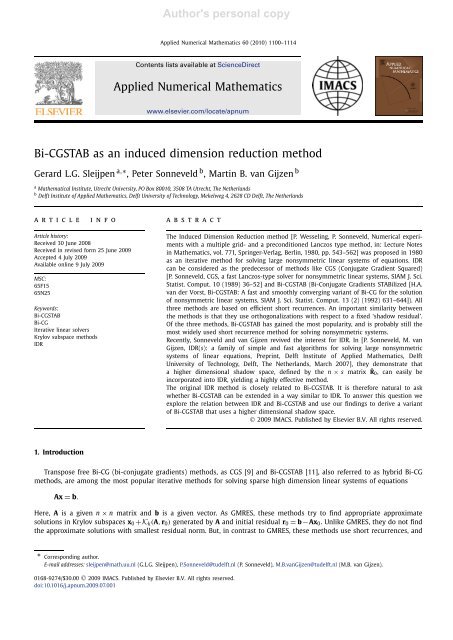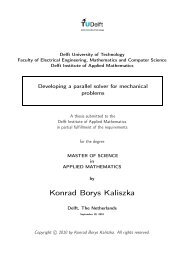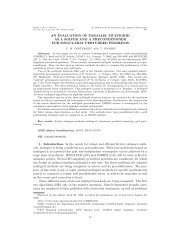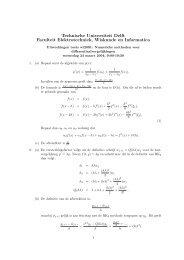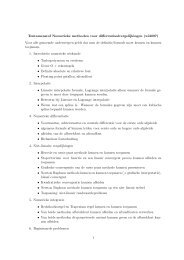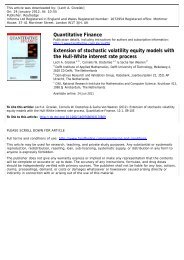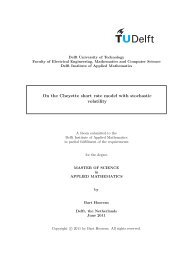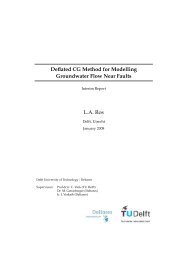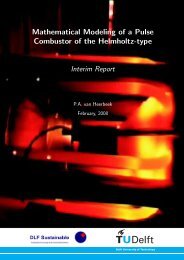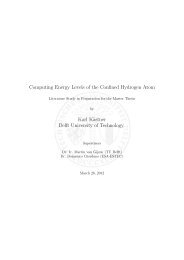Gerard L.G. Sleijpen, Peter Sonneveld and Martin B. van Gijzen, Bi ...
Gerard L.G. Sleijpen, Peter Sonneveld and Martin B. van Gijzen, Bi ...
Gerard L.G. Sleijpen, Peter Sonneveld and Martin B. van Gijzen, Bi ...
You also want an ePaper? Increase the reach of your titles
YUMPU automatically turns print PDFs into web optimized ePapers that Google loves.
Author's personal copy<br />
Applied Numerical Mathematics 60 (2010) 1100–1114<br />
Contents lists available at ScienceDirect<br />
Applied Numerical Mathematics<br />
www.elsevier.com/locate/apnum<br />
<strong>Bi</strong>-CGSTAB as an induced dimension reduction method<br />
<strong>Gerard</strong> L.G. <strong>Sleijpen</strong> a,∗ , <strong>Peter</strong> <strong>Sonneveld</strong> b , <strong>Martin</strong> B. <strong>van</strong> <strong>Gijzen</strong> b<br />
a Mathematical Institute, Utrecht University, PO Box 80010, 3508 TA Utrecht, The Netherl<strong>and</strong>s<br />
b Delft Institute of Applied Mathematics, Delft University of Technology, Mekelweg 4, 2628 CD Delft, The Netherl<strong>and</strong>s<br />
article info abstract<br />
Article history:<br />
Received 30 June 2008<br />
Received in revised form 25 June 2009<br />
Accepted 4 July 2009<br />
Available online 9 July 2009<br />
MSC:<br />
65F15<br />
65N25<br />
Keywords:<br />
<strong>Bi</strong>-CGSTAB<br />
<strong>Bi</strong>-CG<br />
Iterative linear solvers<br />
Krylov subspace methods<br />
IDR<br />
The Induced Dimension Reduction method [P. Wesseling, P. <strong>Sonneveld</strong>, Numerical experiments<br />
with a multiple grid- <strong>and</strong> a preconditioned Lanczos type method, in: Lecture Notes<br />
in Mathematics, vol. 771, Springer-Verlag, Berlin, 1980, pp. 543–562] was proposed in 1980<br />
as an iterative method for solving large nonsymmetric linear systems of equations. IDR<br />
can be considered as the predecessor of methods like CGS (Conjugate Gradient Squared)<br />
[P. <strong>Sonneveld</strong>, CGS, a fast Lanczos-type solver for nonsymmetric linear systems, SIAM J. Sci.<br />
Statist. Comput. 10 (1989) 36–52] <strong>and</strong> <strong>Bi</strong>-CGSTAB (<strong>Bi</strong>-Conjugate Gradients STA<strong>Bi</strong>lized [H.A.<br />
<strong>van</strong> der Vorst, <strong>Bi</strong>-CGSTAB: A fast <strong>and</strong> smoothly converging variant of <strong>Bi</strong>-CG for the solution<br />
of nonsymmetric linear systems, SIAM J. Sci. Statist. Comput. 13 (2) (1992) 631–644]). All<br />
three methods are based on efficient short recurrences. An important similarity between<br />
the methods is that they use orthogonalizations with respect to a fixed ‘shadow residual’.<br />
Of the three methods, <strong>Bi</strong>-CGSTAB has gained the most popularity, <strong>and</strong> is probably still the<br />
most widely used short recurrence method for solving nonsymmetric systems.<br />
Recently, <strong>Sonneveld</strong> <strong>and</strong> <strong>van</strong> <strong>Gijzen</strong> revived the interest for IDR. In [P. <strong>Sonneveld</strong>, M. <strong>van</strong><br />
<strong>Gijzen</strong>, IDR(s): a family of simple <strong>and</strong> fast algorithms for solving large nonsymmetric<br />
systems of linear equations, Preprint, Delft Institute of Applied Mathematics, Delft<br />
University of Technology, Delft, The Netherl<strong>and</strong>s, March 2007], they demonstrate that<br />
a higher dimensional shadow space, defined by the n × s matrix ˜R0 , can easily be<br />
incorporated into IDR, yielding a highly effective method.<br />
The original IDR method is closely related to <strong>Bi</strong>-CGSTAB. It is therefore natural to ask<br />
whether <strong>Bi</strong>-CGSTAB can be extended in a way similar to IDR. To answer this question we<br />
explore the relation between IDR <strong>and</strong> <strong>Bi</strong>-CGSTAB <strong>and</strong> use our findings to derive a variant<br />
of <strong>Bi</strong>-CGSTAB that uses a higher dimensional shadow space.<br />
© 2009 IMACS. Published by Elsevier B.V. All rights reserved.<br />
1. Introduction<br />
Transpose free <strong>Bi</strong>-CG (bi-conjugate gradients) methods, as CGS [9] <strong>and</strong> <strong>Bi</strong>-CGSTAB [11], also referred to as hybrid <strong>Bi</strong>-CG<br />
methods, are among the most popular iterative methods for solving sparse high dimension linear systems of equations<br />
Ax = b.<br />
Here, A is a given n × n matrix <strong>and</strong> b is a given vector. As GMRES, these methods try to find appropriate approximate<br />
solutions in Krylov subspaces x 0 +K k (A, r 0 ) generated by A <strong>and</strong> initial residual r 0 = b−Ax 0 . Unlike GMRES, they do not find<br />
the approximate solutions with smallest residual norm. But, in contrast to GMRES, these methods use short recurrences, <strong>and</strong><br />
*<br />
Corresponding author.<br />
E-mail addresses: sleijpen@math.uu.nl (G.L.G. <strong>Sleijpen</strong>), P.<strong>Sonneveld</strong>@tudelft.nl (P. <strong>Sonneveld</strong>), M.B.<strong>van</strong><strong>Gijzen</strong>@tudelft.nl (M.B. <strong>van</strong> <strong>Gijzen</strong>).<br />
0168-9274/$30.00 © 2009 IMACS. Published by Elsevier B.V. All rights reserved.<br />
doi:10.1016/j.apnum.2009.07.001


